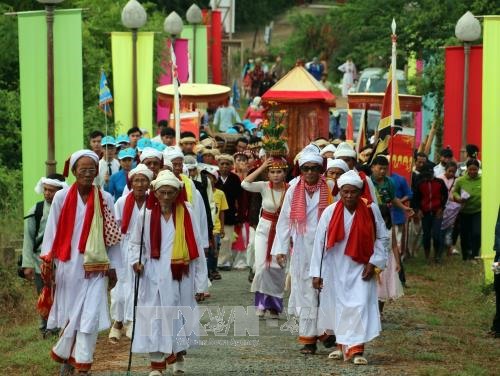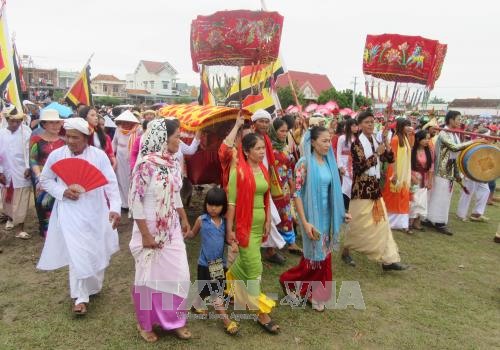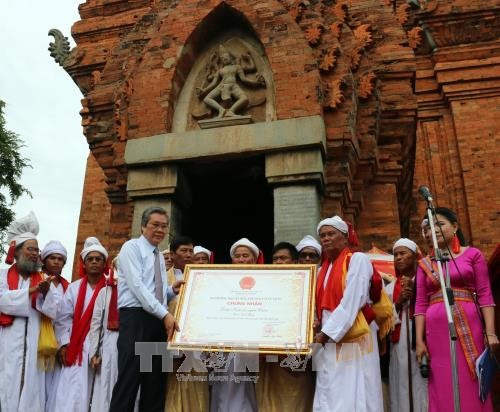 Life & Style
Life & Style

Katê Festival, the largest traditional festival of the ethnic Chăm in the country, has been recognised by the Ministry of Culture, Sports and Tourism as an intangible cultural heritage.
 |
| Celebration: The Katê Festival of the Chăm community in Ninh Thuận Province on October 18-20. — VNA/VNS Photo Đức Ánh |
HCM CITY — Katê Festival, the largest traditional festival of Viet Nam’s Chăm ethnicity people, has been recognised by the Ministry of Culture, Sports and Tourism as an intangible cultural heritage.
The ministry made the announcement on Thursday at the Pô Klông Garai Temple on the occasion of the Katê festival in the central province of Ninh Thuận.
The Katê festival is held annually for three days in the seventh lunar month, which fell on October 18-20 this year. The event is an opportunity for the Chăm to show their gratitude to kings, mandarins and ancestors.
The Chăm people call their kings and mandarins the Pokal, village genie the Po Play, and ancestors the Mu Kay.
 |
| Colourful: The Katê Festival of the Chăm community in Ninh Thuận Province on October 18-20. — VNA/VNS Photo Đức Ánh |
The first day of the festival begins with a thanksgiving ceremony to the Po Play in villages.
On the second day, the Chăm give offerings to the Pokal at ancient temples to pray for a peaceful and happy life. From the third day, they celebrate at home to honour their ancestors.
During the festival, people wear traditional clothes to join in rituals and cultural activities, folk dances, musical performances with traditional instruments, and folk games.
The Katê is the Chăm’s most important festival. It has been known as one of the 15 largest festivals in the country, attracting thousands of locals as well as domestic and international visitors every year.
 |
| Honoured: The Katê Festival, the largest traditional festival of the ethnic Chăm, has been regconised as an intangible cultural heritage by the Ministry of Culture, Sports and Tourism. — VNA/VNS Photo Đức Ánh |
National heritage
The Chăm people’s ancient pottery tradition, which survives in Bàu Trúc Village in the central province of Ninh Thuận, also received recognition as national intangible cultural heritage.
Speaking at the ceremony, held within the festival, vice chairman of Ninh Thuận Province’s People’s Committee, Lê Văn Bình, said the recognition would honour the cultural values of the Chăm.
Binh added that the title would bring more opportunities to promote provincial and local tourism.
To preserve the heritage, Bình called for the efforts of local people and organisations.
 |
| Beauty: The Katê Festival of the Chăm community in Ninh Thuận Province takes place at the Chàm Tower Pô Klông Garai on October 18-20. — VNA/VNS Photo Đức Ánh |
General Director of Ninh Thuận Province’s Department of Culture, Sports and Tourism Châu Thanh Hải said the unique feature of Bầu Trúc Village pottery lies in its manual shaping without the use of a potter’s wheel. The Chăm people use their hands to create soulful pottery products in diverse shapes and sizes, including traditional designs, such as Apsara statues, water jars and decorative lamps, vases and bas-reliefs.
The pottery is fired with straw or wood in the open air on bare land. This creates different shades on each piece, making them unique.
The heritage recognition is a first step for Ninh Thuận Province in producing measures to preserve and promote local heritage and culture.
Bầu Trúc pottery village is one of the oldest ceramic villages in Southeast Asia. About 85 per cent of the village’s 400 households make pottery. — VNS



.jpg)
